E907 小核开发
E907 平台
玄铁E907 是一款完全可综合的高端 MCU 处理器。它兼容 RV32IMAC 指令集,提供可观的整型性能提升以及高能效的浮点性能。E907 的主要特性包括:单双精度浮点单元,以及快速中断响应。
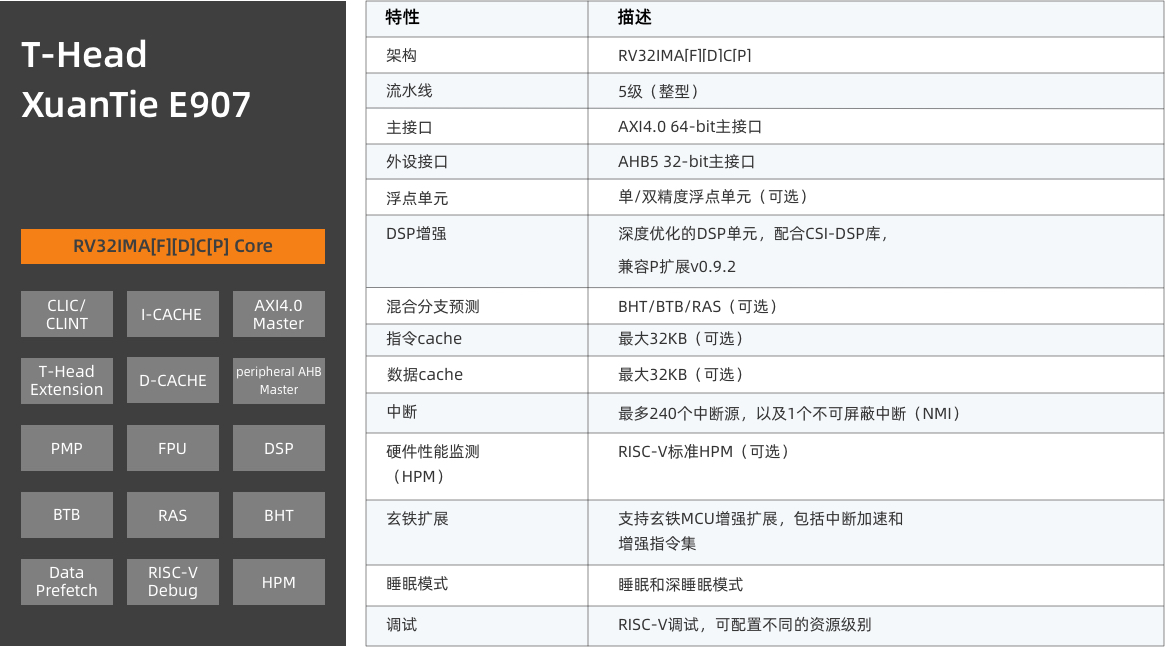
在V85x平台中使用的E907为RV32IMAC,不包括 P 指令集。
芯片架构图
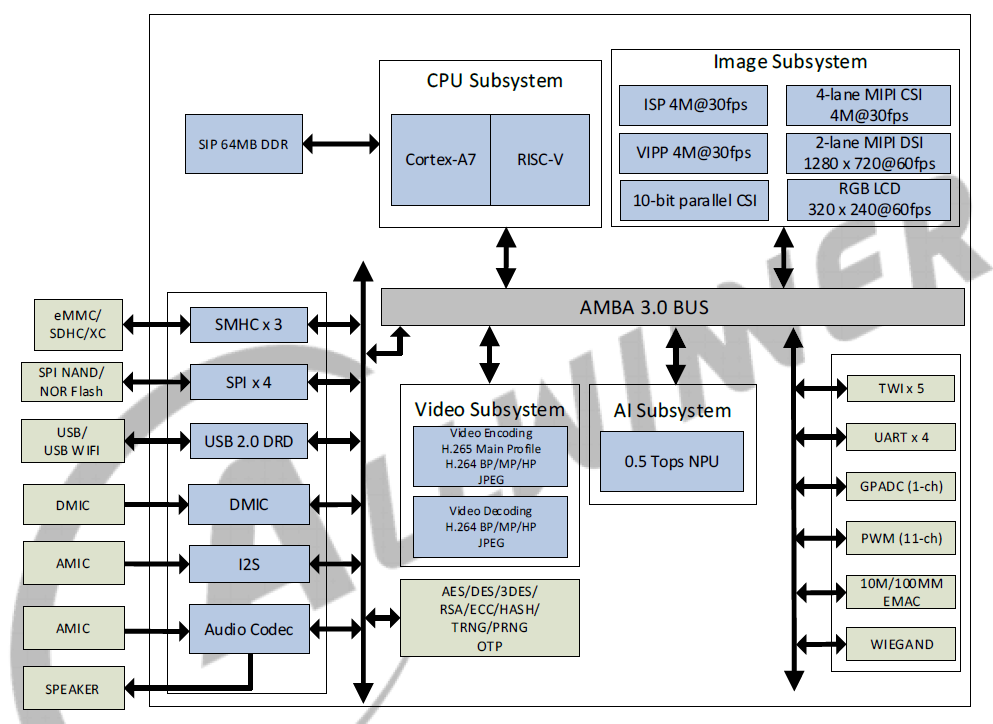
相关内存分布


E907 子系统框图
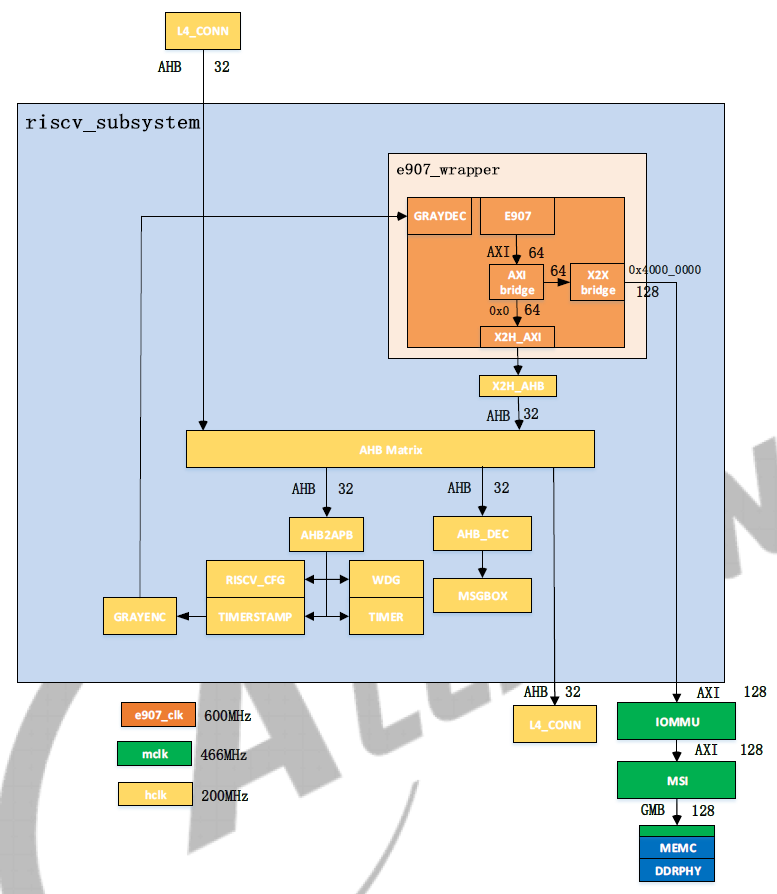
具体的寄存器配置项这里就不过多介绍了,具体可以参考数据手册
V853 的异构系统通讯在硬件上使用的是 MSGBOX,在软件层面上使用的是 AMP 与 RPMsg 通讯协议。其中 A7 上基于 Linux 标准的 RPMsg 驱动框架,E907基于 OpenAMP 异构通信框架。
AMP 与 RPMsg
V851 所带有的 A7 主核心与 E907 辅助核心是完全不同的两个核心,为了最大限度的发挥他们的性能,协同完成某一任务,所以在不同的核心上面运行的系统也各不相同。这些不同架构的核心以及他们上面所运行的软件组合在一起,就成了 AMP 系统 (Asymmetric Multiprocessing System, 异构多处理系统)。
由于两个核心存在的目的是协同的处理,因此在异构多处理系统中往往会形成 Master - Remote 结构。主核心启动后启动从核心。当两个核心上的系统都启动完成后,他们之间就通过 IPC(Inter Processor Communication)方式进行通信,而 RPMsg 就是 IPC 中的一种。
在AMP系统中,两个核心通过共享内存的方式进行通信。两个核心通过 AMP 中断来传递讯息。内存的管理由主核负责。
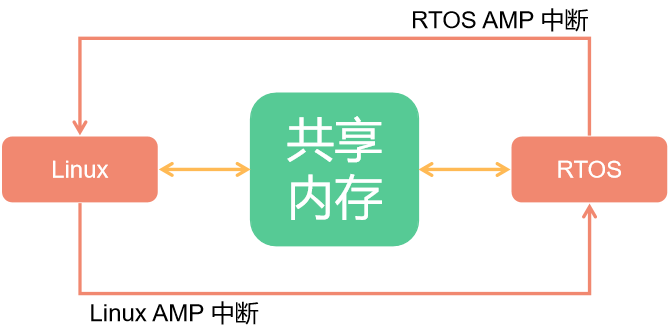
软件适配
这部分使用BSP开发包即可,配置设备树如下:
reserved-memory { // 配置预留内存区间
e907_dram: riscv_memserve { // riscv 核心使用的内存
reg = <0x0 0x43c00000 0x0 0x00400000>; // 起始地址 0x43c00000 长度 4MB
no-map;
};
vdev0buffer: vdev0buffer@0x43000000 { // vdev设备buffer预留内存
compatible = "shared-dma-pool";
reg = <0x0 0x43000000 0x0 0x40000>;
no-map;
};
vdev0vring0: vdev0vring0@0x43040000 { // 通讯使用的vring设备0
reg = <0x0 0x43040000 0x0 0x20000>;
no-map;
};
vdev0vring1: vdev0vring1@0x43060000 { // 通讯使用的vring设备1
reg = <0x0 0x43060000 0x0 0x20000>;
no-map;
};
};
e907_rproc: e907_rproc@0 { // rproc相关配置
compatible = "allwinner,sun8iw21p1-e907-rproc";
clock-frequency = <600000000>;
memory-region = <&e907_dram>, <&vdev0buffer>,
<&vdev0vring0>, <&vdev0vring1>;
mboxes = <&msgbox 0>;
mbox-names = "mbox-chan";
iommus = <&mmu_aw 5 1>;
memory-mappings =
/* DA len PA */
/* DDR for e907 */
< 0x43c00000 0x00400000 0x43c00000 >;
core-name = "sun8iw21p1-e907";
firmware-name = "melis-elf";
status = "okay";
};
rpbuf_controller0: rpbuf_controller@0 { // rpbuf配置
compatible = "allwinner,rpbuf-controller";
remoteproc = <&e907_rproc>;
ctrl_id = <0>; /* index of /dev/rpbuf_ctrl */
iommus = <&mmu_aw 5 1>;
status = "okay";
};
rpbuf_sample: rpbuf_sample@0 {
compatible = "allwinner,rpbuf-sample";
rpbuf = <&rpbuf_controller0>;
status = "okay";
};
msgbox: msgbox@3003000 { // msgbox配置
compatible = "allwinner,sunxi-msgbox";
#mbox-cells = <1>;
reg = <0x0 0x03003000 0x0 0x1000>,
<0x0 0x06020000 0x0 0x1000>;
interrupts = <GIC_SPI 0 IRQ_TYPE_LEVEL_HIGH>,
<GIC_SPI 1 IRQ_TYPE_LEVEL_HIGH>;
clocks = <&clk_msgbox0>;
clock-names = "msgbox0";
local_id = <0>;
status = "okay";
};
e907_standby: e907_standby@0 {
compatible = "allwinner,sunxi-e907-standby";
firmware = "riscv.fex";
mboxes = <&msgbox 1>;
mbox-names = "mbox-chan";
power-domains = <&pd V853_PD_E907>;
status = "okay";
};内存划分
在设备树配置小核心使用的内存,包括小核自己使用的内存,设备通信内存,回环内存等等,这里E907 运行在 DRAM 内。内存起始地址可以在数据手册查到。

通常来说我们把内存地址设置到末尾,例如这里使用的 V851s,拥有 64MByte 内存,则内存范围为 0x40000000 - 0x44000000,这里配置到 0x43c00000 即可。对于 V853s 拥有 128M 内存则可以设置到 0x47C00000,以此类推。对于交换区内存则可以配置在附近。
reserved-memory { // 配置预留内存区间
e907_dram: riscv_memserve { // riscv 核心使用的内存
reg = <0x0 0x43c00000 0x0 0x00400000>; // 起始地址 0x43c00000 长度 4MB
no-map;
};
vdev0buffer: vdev0buffer@0x43000000 { // vdev设备buffer预留内存
compatible = "shared-dma-pool";
reg = <0x0 0x43000000 0x0 0x40000>;
no-map;
};
vdev0vring0: vdev0vring0@0x43040000 { // 通讯使用的vring设备0
reg = <0x0 0x43040000 0x0 0x20000>;
no-map;
};
vdev0vring1: vdev0vring1@0x43060000 { // 通讯使用的vring设备1
reg = <0x0 0x43060000 0x0 0x20000>;
no-map;
};
};
然后需要配置下 e907 的链接脚本,找到 e907_rtos/rtos/source/projects/v851-e907-lizard/kernel.lds 将 ORIGIN 配置为上面预留的内存。
MEMORY
{
/*DRAM_KERNEL: 4M */
DRAM_SEG_KRN (rwx) : ORIGIN = 0x43c00000, LENGTH = 0x00400000
}
然后配置小核的 defconfig 位于 e907_rtos/rtos/source/projects/v851-e907-lizard/configs/defconfig 配置与其对应即可。
CONFIG_DRAM_PHYBASE=0x43c00000
CONFIG_DRAM_VIRTBASE=0x43c00000
CONFIG_DRAM_SIZE=0x0400000
配置启动小核
配置启动小核的流程如下,这里只讨论使用 linux 启动小核的情况,不讨论快启相关。
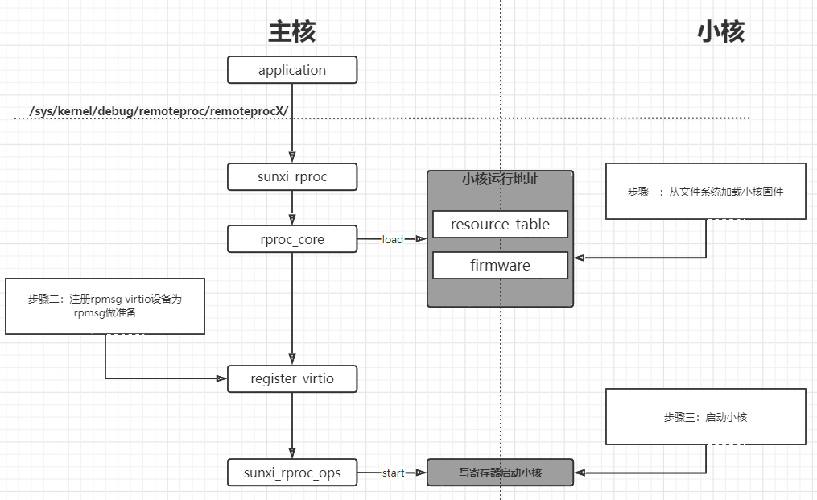
- 加载固件
- 调用
firmware接口获取文件系统中的固件 - 解析固件的
resource_table段,该段有如下内容- 声明需要的内存(
Linux为其分配,设备树配置) - 声明使用的
vdev(固定为一个) - 声明使用的
vring(固定为两个)
- 声明需要的内存(
- 将固件加载到指定地址
- 调用
- 注册
rpmsg virtio设备- 提供
vdev->ops(基于virtio接口实现的) - 与
rpmsg_bus驱动匹配,完成rpmsg初始化
- 提供
- 启动小核
- 调用
rproc->ops->start
- 调用
加载固件
驱动位于 kernel/linux-4.9/drivers/remoteproc/sunxi_rproc_firmware.c
首先调用 sunxi_request_firmware 函数
int sunxi_request_firmware(const struct firmware **fw, const char *name, struct device *dev)
{
int ret, index;
struct firmware *fw_p = NULL;
u32 img_addr, img_len;
ret = sunxi_find_firmware_storage();
if (ret < 0) {
dev_warn(dev, "Can't finded boot_package head\n");
return -ENODEV;
}
index = ret;
ret = sunxi_firmware_get_info(dev, index, name, &img_addr, &img_len);
if (ret < 0) {
dev_warn(dev, "failed to read boot_package item\n");
ret = -EFAULT;
goto out;
}
ret = sunxi_firmware_get_data(dev, index, img_addr, img_len, &fw_p);
if (ret < 0) {
dev_err(dev, "failed to read Firmware\n");
ret = -ENOMEM;

